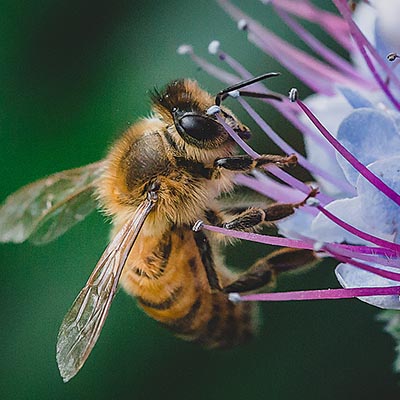 Do You Know That...
Do You Know That...
As the backbone of U.S. agriculture, honeybees:
- pollinate 1/3 of the human diet
- pollinate 50 different U.S. crops valued at over $20 billion
- pollinate $2.5 billion of California's almond production
- produce $150 million worth of honey and beeswax in the U.S.
Honeybees are interesting insects.
- The average honeybee can fly at a speed of 15 mph.
- An average worker honeybee makes about 1/12th of a teaspoon of honey in her lifetime.
- Honeybees need to tap 2 million flowers to make one pound of honey.
- It would take about one ounce of honey to fuel a bee’s flight around the Earth.
- Honeybees are social insects. That means they live and work together in a colony or hive.
- There may be 10,000 to 80,000 workers in a single hive—but only one queen.
- Honeybees are not aggressive by nature. They will not sting unless they are protecting their hive or are unduly provoked.
- Honeybees dance to communicate the direction and distance of nectar sources. The round dance is performed by bees that find food within 100 meters of the hive. The wag-tail dance is performed by bees that find food more than 100 meters from the hive.
- The hive is made from beeswax. Eating honey makes it possible for worker bees to produce beeswax. The beeswax is formed into a six-sided wax comb in which the bees store honey and pollen. The comb is also where the egg, larvae, and pupa stage of the honeybee is found.
- Honeybees collect nectar and pollen from flowers. Both are stored in the hive where nectar is converted to honey, and pollen is fermented into bee bread.
- Bees eat honey and bee bread. Bee bread provides protein, while honey is a source of carbohydrates. Both pollen and honey contain minerals, vitamins, and enzymes.
- To make honey, bees drop the collected nectar into the comb and then evaporate it by fanning their wings. Once enough moisture/water has been evaporated, the bees cap over the honey.
More Honey Bee Facts
- Honeybees are not native to North America. They were brought over by the early settlers from Europe.
- There are more than 200,000 beekeepers who maintain 3.2 million colonies in the United States.
- Utah is known as the Beehive State.
- South Dakota, North Dakota, Florida, and California are the biggest honey-producing states.
- Honey does not spoil. If it crystallizes in the container, just put it in a hot water bath until it liquefies. Do not heat it in the microwave as this could burn the honey.
- The fructose in honey makes it sweeter than sugar. At 21 calories a teaspoon, it is 1½ times sweeter than sugar.
- Honey makes baked goods brown faster and improves shelf life.
- Honey varies in color from almost clear to dark brown. The color and taste depend on the flowers the bees visit. Clover honey is light and very sweet. Buckwheat honey is dark, strong-tasting honey.
- Beekeepers in Indiana harvest an average of 60 to 80 pounds of honey per hive. The beekeeper also needs to make sure the beehive has 60 to 80 pounds of stored honey for the winter.
